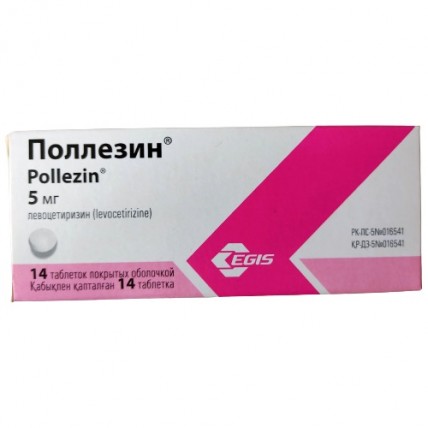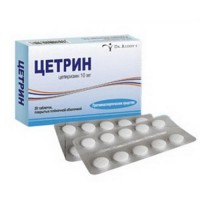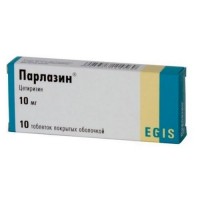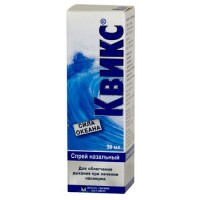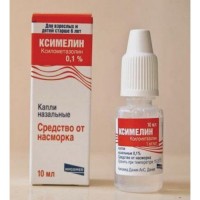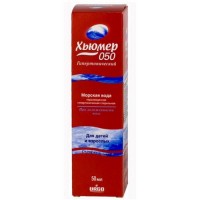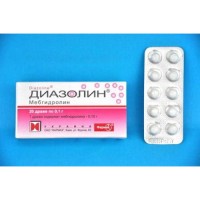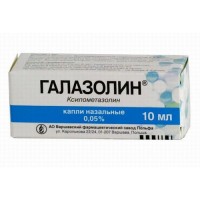Pollezin® (Levocetirizine) 5 mg, 14 coated tablets
- $19.80
Composition
One tablet contains the active ingredient - levocetirizine dihydrochloride 5 mg (equivalent to 4.21 mg levocetirizine)
Pharmacological properties
Pharmacokinetics
After oral administration, levocetirizine is rapidly absorbed from the gastrointestinal tract. Eating does not affect the completeness of absorption, although its rate decreases. The maximum plasma concentration is reached 0.9 hours after a single oral dose. Steady state is reached after 2 days. The maximum concentration after a single and repeated (5 mg daily) administration is 270 ng / ml and 308 ng / ml, respectively. Binding to plasma proteins - 90%. Data on the distribution of the drug in tissues and penetration through the blood-brain barrier are not available. The volume of distribution is 0.4 l/kg. Less than 14% of an administered dose is metabolized in the liver by aromatic ring oxidation, N- and O- dealkylation , and taurine conjugation. Dealkylation is predominantly catalyzed by CYP 3A4, and CYP isoforms are involved in the oxidation of the aromatic ring. Levocetirizine does not affect the activity of CYP isoenzymes IA2, 2C9, 2C19, 2D6, 2E1 and 3A4 at concentrations much higher than peak concentrations with oral administration of 5 mg. Due to the negligible metabolism and lack of metabolic suppression, the interaction of levocetirizine with other substances is unlikely. The half-life is 7.9 ± 1.9 hours. The total clearance is 0.63 ml / min / kg. Levocetirizine and its metabolite are excreted mainly by the kidneys (85.4% of the dose), by glomerular filtration and active tubular secretion. Excretion through the intestines is 12.9%. Penetrates into breast milk. Pharmacokinetics levocetirizine is linear, independent of dose and time, and has little variation between subjects. The pharmacokinetic profiles of the single enantiomer and cetirizine are similar. There is no chiral inversion during absorption or excretion.
Impaired kidney function
The apparent body clearance of levocetirizine correlates with creatinine clearance. Therefore, it is recommended to clarify the intervals between doses of levocetirizine based on creatinine clearance in patients with moderate or severe renal impairment. In the anuric stage of renal disease, total body clearance is reduced by about 80% compared to healthy subjects. With a standard 4-hour hemodialysis procedure, less than 10% of levocetirizine is excreted.
Pharmacodynamics
THE ACTIVE SUBSTANCE OF POLLEZIN - LEVOCETIRIZINE, (R) ENANTIOMER OF CETIRIZINE, IS A STRONG SELECTIVE ANTAGONIST OF PERIPHERAL H1-RECEPTORS.
The affinity of levocetirizine ( Ki = 3.2 nmol /l) with histamine H1 receptors is 2 times higher than that of cetirizine ( Ki = 6.3 nmol /l). Pharmacokinetic studies in healthy volunteers have shown that when applied to the skin and nasal mucosa at half the dose, the activity of levocetirizine is comparable to that of cetirizine. Levocetirizine inhibits the activity of eotaxin -induced transendothelial migration of eosinophils in skin and lung cells. Pharmacodynamic studies have demonstrated three main inhibitory effects of levocetirizine at a dose of 5 mg in the first 6 hours after exposure to pollen: suppression of VCAM-1 release, alteration of vascular permeability, and reduction of eosinophil activation. As with cetirizine , the effect on histamine-induced skin reactions is independent of plasma concentrations of the drug.
Pollezin prevents the development and facilitates the course of allergic reactions, has an antiexudative , antipruritic effect; practically no anticholinergic and antiserotonin action.
Levocetirizine at a dose of 5 mg promotes inhibition of the inflammatory - exudative reaction to histamine, as does cetirizine at a dose of 10 mg. ECG showed no significant effect of levocetirizine on the QT interval.
INDICATIONS FOR USE
- treatment of symptoms of year-round and seasonal allergic rhinitis (including persistent allergic rhinitis) and allergic conjunctivitis: sneezing, rhinorrhea , lacrimation, conjunctival hyperemia
- hay fever (pollinosis)
Urticaria, including chronic idiopathic urticaria
- other allergic dermatoses accompanied by itching and rashes
- angioedema
Dosage and administration
Tablets are taken orally, swallowed whole with a little water; regardless of food intake. The daily dose is recommended to be taken at one time.
Children over 6 years of age and adults: The recommended dose is 1 tablet per day.
Elderly patients with moderate or severe renal impairment are advised to adjust the dose.
In patients with impaired renal function, the frequency of administration should be set individually in accordance with renal function. The table below shows the necessary dose changes. To use this table, the patient's creatinine clearance ( Clcr ) in ml/min should be estimated. After determining the level of serum creatinine (mg / dL ), the value of Clcr (ml / min) can be estimated using the following formula:
For men:
´ weight (kg)
Ccr = ———————————————
0.82 ´ serum creatinine ( µmol /l)
For women: derived value ´ 0.85
Dose adjustment for patients with impaired renal function:
| Group | Clearance creatinine (ml/min) | Dose and frequency of administration |
| Normal kidney function | 80 | 5 mg per day |
| Mild impairment of kidney function | 50-79 | 5 mg per day |
| Moderate renal impairment | 30 - 49 | 5 mg every other day |
| Severe impairment of kidney function | < 30 | 5 mg 1 time in 3 days |
| End-stage kidney disease - dialysis patients | < 10 | Contraindicated |
Patients with impaired liver function
When prescribing the drug to patients with isolated liver dysfunction, no dose changes are required. Dose adjustment is recommended for patients with combined hepatic and renal dysfunction.
The duration of treatment depends on the type, duration and course of symptoms. Treatment of hay fever requires 3-6 weeks, and for short-term exposure to pollen, taking the drug for 1 week is usually sufficient. There is currently clinical experience with levocetirizine in coated tablets for 6 months. Racemate has been used for up to 1 year for chronic urticaria and chronic allergic rhinitis, and for up to 18 months for pruritus associated with atopic dermatitis.
Side effects
Often: (<1/10 and > 1/100)
- headache, drowsiness, fatigue
- dry mouth
Uncommon (<1/100 and >1/1000)
- asthenia
- abdominal pain
Very rare (<1/10000)
- allergic reactions, including anaphylaxis
- angioedema, itching, skin rash, urticaria
- increase in body weight
- dyspnea
- nausea
- abnormal liver function tests
The drug should be discontinued if any of the above effects reaches a clinically significant intensity, and its cause cannot be reliably established.
CONTRAINDICATIONS
- hypersensitivity to levocetirizine , other piperazine derivatives or any of the auxiliary components of the drug
- severe renal failure ( creatinine clearance below 10 ml/min)
- children's age up to 6 years
Drug Interactions
Interaction studies of Pollezin with other drugs (including CYP3A4 inducers) have not been conducted.
There are no clinically significant adverse interactions with pseudoephedrine, cimetidine , ketoconazole , erythromycin, azithromycin , glipizide , and diazepam.
A decrease in clearance of cetirizine (16%) was observed with repeated administration of theophylline (400 mg once a day); while the pharmacokinetics of theophylline with the simultaneous administration of cetirizine did not change.
In susceptible patients, concomitant use of cetirizine or levocetirizine and alcohol or other CNS depressants may affect the central nervous system.
SPECIAL INSTRUCTIONS
Each film-coated tablet contains lactose, therefore it should not be administered to patients with rare hereditary galactose intolerance, hereditary Saami lactase deficiency or glucose-galactose malabsorption syndrome.
should refrain from drinking alcohol while using Pollezin.
Pregnancy and lactation
data from clinical studies of levocetirizine during pregnancy. Therefore, the drug is not recommended for women during pregnancy and lactation.
Influence on the ability to drive vehicles and work with especially dangerous mechanisms
Comparative clinical studies have not revealed signs of impaired wakefulness, reaction time, or ability to drive vehicles after taking the recommended doses of levocetirizine. However, some patients may experience drowsiness, fatigue, or asthenia while taking the drug. It should be used with caution in persons driving vehicles and engaged in activities that require the speed of psychomotor and motor reactions.
Overdose
Symptoms: in adults, drowsiness is possible, in children, at first, agitation and anxiety, which are replaced by drowsiness.
Treatment: There is no specific antidote for levocetirizine.
Symptomatic and supportive treatment is recommended. After a short period of time after taking the drug inside, you can do a gastric lavage. Levocetirizine cannot be effectively removed by hemodialysis.
Storage conditions
Store at a temperature not exceeding 30 oC
Keep out of the reach of children!
Shelf life 3 years
Do not use after the expiration date.
